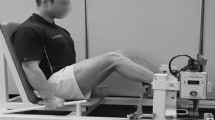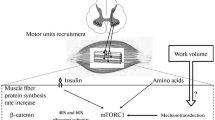Summary
To investigate biochemical, histochemical and contractile properties associated with strength training and detraining, six adult males were studied during and after 10 weeks of dynamic strength training for the quadriceps muscle group of one leg, as well as during and after a subsequent 12 weeks of detraining. Peak torque outputs at the velocities tested (0–270‡·s−1) were increased (p<0.05) by 39–60% and 12–37% after training for the trained and untrained legs, respectively. No significant changes in peak torques were observed in six control subjects tested at the same times. Significant decreases in strength performance of the trained leg (16–21%) and untrained leg (10–15%) were observed only after 12 weeks of detraining. Training resulted in an increase (p≪0.05) in the area of FTa (21%) and FTb (18%) fibres, while detraining was associated with a 12% decrease in FTb fibre cross-sectional area. However, fibre area changes were only noted in the trained leg. Neither training nor detaining had any significant effect on the specific activity of magnesium-activated myofibrillar ATPase or on the activities of enzymes of phosphagen, glycolytic or oxidative metabolism in serial muscle biopsy samples from both legs. In the absence of any changes in muscle enzyme activities and with only modest changes in FT fibre areas in the trained leg, the significant alterations in peak torque outputs with both legs suggest that neural adaptations play a prominent role in strength performance with training and detraining.
Similar content being viewed by others
References
Bergström J (1962) Muscle electrolytes in man. Scand J Clin Lab Invest (Suppl) 68: 1–110
Costill DL, Coyle EF, Fink WF, Lesmes GR, Witzmann FA (1979) Adaptations in skeletal muscle following strength training. J Appl Physiol 46: 96–99
Coyle EF, Feiring DC, Rotkis TC, Cote III RW, Roby FB, Lee W, Wilmore JH (1981) Specificity of power improvements through slow and fast isokinetic training. J Appl Physiol 51: 1437–1442
Green HJ, Thomson JA, Daub WD, Houston ME, Ranney DA (1979) Fiber composition, fiber size and enzyme activities in vastus lateralis of elite athletes involved in high intensity exercise. Eur J Appl Physiol 41: 109–117
Houston ME, Bentzen H, Larsen H (1979) Interrelationship between skeletal muscle adaptations and performance as studied by detraining and retraining. Acta Physiol Scand 105: 163–170
Komi PV, Viitasalo JT, Rauramaa R, Vihko V (1978) Effect of isometric strength training on mechanical, electrical and metabolic aspects of muscle function. Eur J Appl Physiol 40: 45–55
Lowry OH, Rosebrough NJ, Farr AL, Randall RJ (1951) Protein measurement with the folin phenol reagent. J Biol Chem 193: 265–275
MacDougall JD, Elder GCB, Sale DG, Moroz JR, Sutton JR (1980) Effects of strength training and immobilization on human muscle fibres. Eur J Appl Physiol 43: 25–34
Milner-Brown HS, Stein RB, Lee RG (1975) Synchronization of human motor units: possible roles of exercise and supraspinal reflexes. Electroencephalogr Clin Neurophysiol 38: 245–254
Moritani T, DeVries HA (1979) Neural factors versus hypertrophy in the time course of muscle strength gain. Am J Phys Med 58: 115–130
Müller EA (1970) Influence of training and inactivity on muscle strength. Arch Phys Med Rehab 51: 449–462
Samaha FJ (1967) Human striated muscle myofibrils and actomyosin. Neurol 17: 1152–1158
Shaver LG (1975) Cross transfer effects of conditioning and deconditioning on muscular strength. Ergonomics 18: 9–16
Solaro RJ, Pang DC, Briggs FN (1971) The purification of cardiac myofibrils with Triton X-100. Biochim Biophys Acta 245: 259–262
Takashi R, Putnam S (1979) A fluorimetric method for continuously assaying ATPase: application to small specimens of glycerol-extracted muscle fibers. Anal Biochem 92: 375–382
Thorstensson A, Hultén B, von Döbeln W, Karlsson J (1976a) Effect of strength training on enzyme activities and fibre characteristics in human skeletal muscle. Acta Physiol Scand 96: 392–398
Thorstensson A, Grimby G, Karlsson J (1976b) Force-velocity relations and fibre composition in human knee extensor muscles. J Appl Physiol 40: 12–16
Winter DA, Wells RP, Orr GW (1981) Errors in the use of isokinetic dynamometers. Eur J Appl Physiol 46: 397–408
Author information
Authors and Affiliations
Additional information
This study was funded by a grant from the Natural Sciences and Engineering Research Council of Canada
Rights and permissions
About this article
Cite this article
Houston, M.E., Froese, E.A., Valeriote, S.P. et al. Muscle performance, morphology and metabolic capacity during strength training and detraining: A one leg model. Europ. J. Appl. Physiol. 51, 25–35 (1983). https://doi.org/10.1007/BF00952534
Accepted:
Issue Date:
DOI: https://doi.org/10.1007/BF00952534




